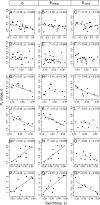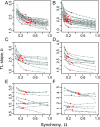Synchrony affects Taylor's law in theory and data
- PMID: 28559312
- PMCID: PMC5495260
- DOI: 10.1073/pnas.1703593114
Synchrony affects Taylor's law in theory and data
Abstract
Taylor's law (TL) is a widely observed empirical pattern that relates the variances to the means of groups of nonnegative measurements via an approximate power law: variance g ≈ a [Formula: see text] mean gb , where g indexes the group of measurements. When each group of measurements is distributed in space, the exponent b of this power law is conjectured to reflect aggregation in the spatial distribution. TL has had practical application in many areas since its initial demonstrations for the population density of spatially distributed species in population ecology. Another widely observed aspect of populations is spatial synchrony, which is the tendency for time series of population densities measured in different locations to be correlated through time. Recent studies showed that patterns of population synchrony are changing, possibly as a consequence of climate change. We use mathematical, numerical, and empirical approaches to show that synchrony affects the validity and parameters of TL. Greater synchrony typically decreases the exponent b of TL. Synchrony influenced TL in essentially all of our analytic, numerical, randomization-based, and empirical examples. Given the near ubiquity of synchrony in nature, it seems likely that synchrony influences the exponent of TL widely in ecologically and economically important systems.
Keywords: Moran effect; aphid; correlation; fluctuation scaling; mean variance scaling.
Conflict of interest statement
The authors declare no conflict of interest.
Figures



Comment in
-
Unfinished synchrony.Proc Natl Acad Sci U S A. 2017 Jun 27;114(26):6658-6660. doi: 10.1073/pnas.1707731114. Epub 2017 Jun 12. Proc Natl Acad Sci U S A. 2017. PMID: 28607083 Free PMC article. No abstract available.
References
-
- Taylor LR. Aggregation, variance and the mean. Nature. 1961;189:732–735.
-
- Döring TF, Knapp S, Cohen JE. Taylor’s power law and the stability of crop yields. Field Crops Res. 2015;183:294–302.
-
- Kuo TC, Mandal S, Yamauchi A, Hsieh CH. Life history traits and exploitation affect the spatial mean-variance relationship in fish abundance. Ecology. 2016;97:1251–1259. - PubMed
-
- Xu M, Kolding J, Cohen JE. Taylor’s power law and fixed precision sampling: Application to abundance of fish sampled by gillnets in an African lake. Can J Fish Aquat Sci. 2017;74:87–100.
-
- Taylor LR, Perry JN, Woiwod IP, Taylor RAJ. Specificity of the spatial power-law exponent in ecology and agriculture. Nature. 1988;332:721–722.
Publication types
Grants and funding
LinkOut - more resources
Full Text Sources
Other Literature Sources

